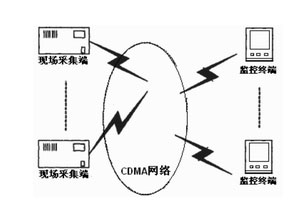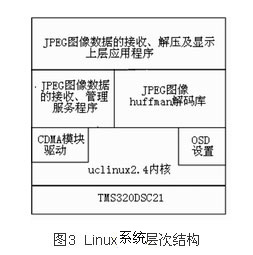The monitoring system is based on the TMS320DSC21 embedded processor platform and embedded Linux system, and is divided into a remote field acquisition terminal and a local monitoring terminal, which are transmitted through a CDMA wireless network, as shown in FIG. The field acquisition terminal collects and monitors the single frame image and video continuous frame of the scene and encodes it into M-JPEG and saves it into a file, which is then transmitted to the local monitoring terminal through the CDMA network. After receiving the image data, the monitoring terminal enters M-JPEG decoding and displays it on the analog LCD screen. M-JPEG adopts an intra-frame compression algorithm, which can achieve a high compression ratio for objects that have not changed for a long time, and has a low cost, thereby realizing remote observation under limited bandwidth. This article mainly introduces the design of the monitoring terminal.
System hardware structure
The hardware structure of the system monitoring terminal is shown in Figure 2.
 Figure 1 Wireless image monitoring system structure |
 Figure 2 system hardware structure |
The CPU uses TI's chip TMS320DSC21. The chip is a DSP digital image processor based on multi-processor architecture introduced by TI. It uses an ARM7 32-bit RISC microcontroller to handle non-imaging functions and is used as the primary controller for the entire system, while processing the image decoding with the programmable C5409 DSP core. In addition, the DSC21 integrates a programmable coprocessor dedicated to handling most complex computational image tasks. One of the coprocessors, the image processing engine iMX, performs DCT, inverse DCT, and other coprocessors perform variable length encoding/decoding, quantization, and inverse quantization.
The power module is responsible for the smooth output and monitoring of the power supply.
The CDMA wireless receiving module receives the JPEG data stream and stores it in the SDRAM. The image display module displays the decompressed original image on a television or analog LCD screen. The memory module is composed of FLASH and SDRAM. FLASH memory is used to store programs and is an integral part of the system's independent operation (offline operation). SDRAM memory is used for the operation of system software and the storage of image data. This allows the previous image data to be recalled for research.
The debug emulation module is used to debug the emulation, and it can also import image data from the SDRAM into the computer.
 |
The system is designed based on the open source Linux operating system. The system is ported to version 2.4. The hierarchical structure of the entire Linux system is shown in Figure 3.
The whole Linux system is based on the TMS320DSC21 hardware platform introduced above. The main drivers required for the hardware of the system are CDMA module driver and OSD image display driver. The driver abstracts the underlying hardware and provides a consistent underlying interface to the top-level application. The JPEG image data receiving and management program, as a resident daemon thread, constantly monitors the activity of the underlying CDMA module and provides relevant interface functions to the upper application layer program.
 Figure 4 JPEG decoding flow chart |
The top-level application layer program acquires image data received from the CDMA driver through the JPEG image data receiving and management service program, and then decompresses the image by calling the huffman decoding library, and then stores the decompressed YUV data into the SDRAM, and then maps to the OSD area. Displayed through the LCD screen.
JPEG decoding implementation of images
The mclinux system controls the DSP to perform JPEG decoding. After preprocessing, Huffman decoding, inverse quantization, and IDCT transformation, the JPEG image data is restored to the image data before compression encoding, and then processed by the OSD and finally displayed on the LCD screen. The image comes. The detailed process is shown in Figure 4.
Wireless transmission of image data using CDMA module
CDMA is Code Division Multiple Access, a mobile communication technology developed on the branch of digital technology, spread spectrum communication technology. Different mobile stations share a frequency application spread spectrum communication technique to assign a unique, random code sequence to each mobile station, each code sequence being different from each other and not related to each other. Its capacity is close to twice the capacity of previous CDMA 1× systems, enabling it to adapt to the growing demand for voice services and wireless Internet services. Secondly, its maximum download speed can reach 153kbps (up to 307kbps in the future) and the upload speed is 64K. Such speed is sufficient for the transmission of 352x288 M-JPEG compressed image data of about 4 frames per second.
In order to transmit data accurately and with as little data redundancy as possible, the underlying system of the system refers to the XMODEM protocol.
The XMODEM protocol is an asynchronous file transport protocol widely used in personal computer communications using dial-up modems. This protocol transmits data in blocks of 128 bytes, and each block uses a checksum procedure for error detection. If the receiver's checksum for a block is the same as its checksum at the sender, if the packet is successfully received, the receiver will return an acknowledge signal (ACK), and if an error is found, a negative acknowledge signal will be returned ( NAK) and resend the packet. However, this strategy of recognizing each block will result in low performance, especially in the case of CDMA connections with very long propagation delays.
 |
Conclusion
This paper mainly completed the design of the monitoring terminal and tested it. When the monitoring object did not move vigorously, it achieved a transmission speed of 4 frames per second under the bandwidth of 20kbps, and achieved the expected goal. Fig. 5 is an original image, and Fig. 6 is an image obtained by decoding using the above-described processing flow. Applying the method described in this paper to complete image acquisition and remote transmission, it can be widely used in banks, substations, stations, office buildings and other places. It is more convenient than traditional monitoring methods, and has low cost and broad market and application prospects.
references:
[1]. MPEG1 datasheet http://
[2]. RISC datasheet http://+_1189725.html.
:
Other
Shunxing Hardware Wire Mesh Co., Ltd. , http://www.rywiremesh.com